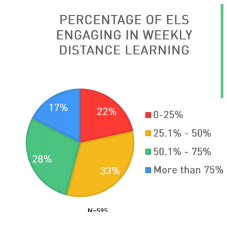Analysis: Educators Say Distance Learning Failed Most English Learners Last Spring. Here’s 10 Ways to More Effectively Serve ELs as Schools Reopen for Virtual and Blended Learning

American schools’ responses to COVID-19’s sudden interruption to public education varied considerably across the nation as students went from daily classroom learning to stay-at-home orders nearly overnight. Now, a new survey reveals the limits of that patchwork response to the emergency — and indicates key lessons for schools’ reopening this fall.

Over the past several months, Californians Together, an English-learner advocacy organization, asked more than 650 educators to provide details about their schools’ distance learning plans, focusing particularly on how they served English learners. The results were sobering. Just 17 percent of respondents reported that most of their ELs were regularly participating in distance learning each week. More than half of the respondents said that the majority of their ELs weren’t participating weekly, which could be due at least in part to the fact that ELs’ families are disproportionately likely to be marginalized by digital divides and reliable internet connectivity. One-third of survey respondents said their districts hadn’t ensured that all ELs had access to the internet this spring for virtual learning through school closures.
Local and state leaders must address these inequities as they prepare to relaunch public education in the fall. Almost half of California’s students speak a non-English language at home. Whether schools open with in-person instruction, rely wholly on distance learning approaches or craft some hybrid mix of these, they must prioritize the needs of EL students. Here is a 10-point road map for how schools can do this effectively:
1. Ensure that ELs have daily access to live interactive instruction
This must come directly from their teachers, whether virtual or in person. Consistent face-to-face interactions are particularly critical for ELs. Students learn more language when they engage in conversations with teachers and fellow students. Plus, live interaction builds relationships, advances social and emotional development, fosters student engagement and grows student achievement.
2. Include relationship-building as part of the curriculum
This spring, schools were able to grow distance learning on “social credit” — teachers could build on the relationships students developed during the first two-thirds of the school year. They will not have that advantage this fall. As they plan for regular live interaction — in person or online — schools will be tempted to hurl themselves purely into academic instruction in an effort to make up for lost educational time. But students learn even more if educators take some time to prioritize relationship-building and social and emotional development early in the school year.
3. Maintain a full, robust curriculum
Similarly, schools must resist any efforts to fast-track ELs’ progress by narrowing their academic experiences. ELs need access to the full curriculum at their schools: math, literacy, science, social studies, music, the arts and more. If they have compelling, interesting school experiences, students will remain engaged — and learn more. If they are force-fed daily remedial math and reading drills, they may well stagnate.
4. Retain language services
Education leaders must also ensure that ELs have access to the English language development instructional services that they are promised under state and federal law. This may take different forms under different learning formats, but schools should prioritize language instructional services for ELs during in-person schooling as soon as public health conditions allow. California’s definition of distance learning includes the requirement for English language development both targeted and through content instruction.
5. Provide access to resources and devices
Schools should build their fall instructional models around ELs who were largely left out of distance learning in the spring. They must make special efforts to ensure that each child has the device and internet access they need to participate in any distance learning this fall. ELs should also be first in line to return to in-person instruction and extended learning opportunities when that becomes available.
6. Keep attendance
As part of their efforts to make fall instruction as equitable as possible, schools must keep meticulous track of student attendance for all learning formats. This will help them identify gaps where digital divides or miscommunication with families are preventing EL students from accessing instruction in different settings. California districts are now required to develop a Learning Continuity and Attendance Plan to track individual student attendance.
7. Involve and communicate with families
Indeed, all of the foregoing will be more difficult — even impossible — if schools fail to communicate with ELs’ families. Effective family communications are just a necessary first step toward meaningful family engagement. Nearly 60 percent of the teachers and administrators who responded to our survey could not say for sure that their districts provided opportunities for ELs’ families to learn strategies to support distance learning at home. These sorts of school-family partnerships will continue to be critical for supporting ELs in the fall — particularly if schools launch new hybrid learning or complete online efforts.
8. Support teachers with resources for a new era of teaching
Education leaders must acknowledge that teachers will need significant resources, support and time to prepare for this fall. When asked about which future EL-related professional development topics would be most useful, more educators in our survey selected “New School Year Procedures” than any other option. To meet this need, states and the federal government must provide time and funding for professional development focused on supporting ELs’ linguistic and academic development — particularly in online distance and/or hybrid learning models.
9. Give teachers more time
Meanwhile, given the unique set of changes teachers will be asked to implement, districts and schools must give them additional time to plan, prepare and collaborate before — and during — the school year.
10. Offer guidance from the top
Federal and state leaders should provide local education officials with guidance on each of these elements: ELs’ daily access to live instruction, a whole-child approach to learning, ongoing language supports, equitable prioritizing of students who missed out on spring instruction, attendance tracking, family engagement and teacher supports.
None of this will be easy, but neither can it be optional. Some schools have already opened for the fall semester, and others are but weeks away from the start of school. Whatever form “reopening” takes, planning, preparation time, resources and communication are critical for education leaders and the education of their students.
Martha Hernandez is executive director of Californians Together, a coalition of 22 parent, professional and civil rights organizations that advocate to improve policy and practice for English learners.
Get stories like these delivered straight to your inbox. Sign up for The 74 Newsletter

;)